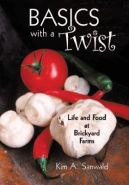As our farm season slowly comes to a close, the tempo at the farm slows down as well. It always seems like a long exhale after tomatoes (we harvested almost 5000 lbs this year). As little as three years ago, after our heirloom tomato season was done, our market stall looked pretty bleak. This year we have gotten our fall crops down. Our stall is teaming with shelling beans, mustard, kale, Swiss chard, collards, leeks, fennel, rutabaga, turnips, arugula, herbs, beets and carrots. The more we understand how seasonal changes affect what we grow, the greater our chance for success. Overall we have had a great year in spite of the record breaking drought. The cooler temperatures have all of us thinking of cooking something savory again, putting up food and preserving it before the first hard frost.
We have been putting up food all season long. Many of our customers wonder how in the world we manage after a full work day and preparing for market. Yet its one of those times that you snooze, you loose. It kills us to purchase produce at the grocery store during the winter, when we grow it ourselves. So far we have roasted tomatoes, made salsa, tomato sauce, tomato soup, dried herbs, dried tomatoes, dried sweet and hot peppers, frozen corn and shelling beans. We will also make pickled beets and freeze greens. Tonight a hard frost is predicted so we decided we better get out and harvest some Swiss chard. After breakfast we donned our rain coats and headed out for the back field. The rows of chard looked so vital and lush. It loves the cooler weather, but will not survive temperatures below freezing without damage. We set about picking 20 gallons or so of the stuff.
We filled a large kettle with water and put it on to boil. In the meantime, we trimmed the stems, then washed the leaves. Next, taking several leaves at a time, we rolled them up into a fat cigar (Fidel, you’d be jealous), then sliced them in 1-inch pieces.
The next step was to blanch the ribbon-ed leaves in boiling water for 1 minute, then put them in cold water to stop the cooking process.
After cooling down the blanched leaves, we needed to remove the water. A salad spinner did the trick.
If you don’t have a salad spinner, you can wring the leaves out gently between tea-towels. It’s important not to have too much water clinging to the leaves before you freeze them. We have a Food-Saver vacuum bag system. Our unit is over 6 years old and going strong. They are really worth the investment as food that is vacuumed-sealed lasts for up to 3 years without freezer-burn.
In just 90 minutes, Val and I had seven 8 cup bags of Swiss chard ready for the freezer. We know its chemical free, grown with love and will end up being enjoyed in various ways from casseroles to soups and stews. We look forward to eating our greens.
We then decided to put up the 4 large heads of cauliflower we purchased from our good friend John Platte. This went even quicker than the chard. We were done in a mere 45 minutes.
We ended up with 10 bags of flowerets ready to be turned into soup, gratins or roasted for pasta.
Putting up produce helps us stay local even in winter. We feel good about filling our larder with vegetables grown either on our own farm or in our area from other local farmers.
“There is no dignity quite so impressive and no independence quite so important as living within your means.” –Calvin Coolidge








